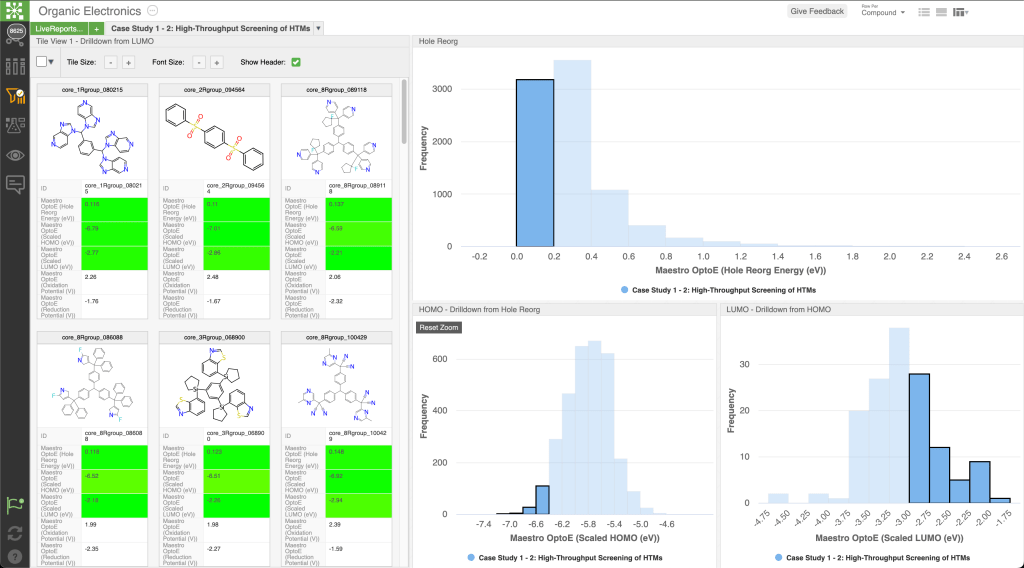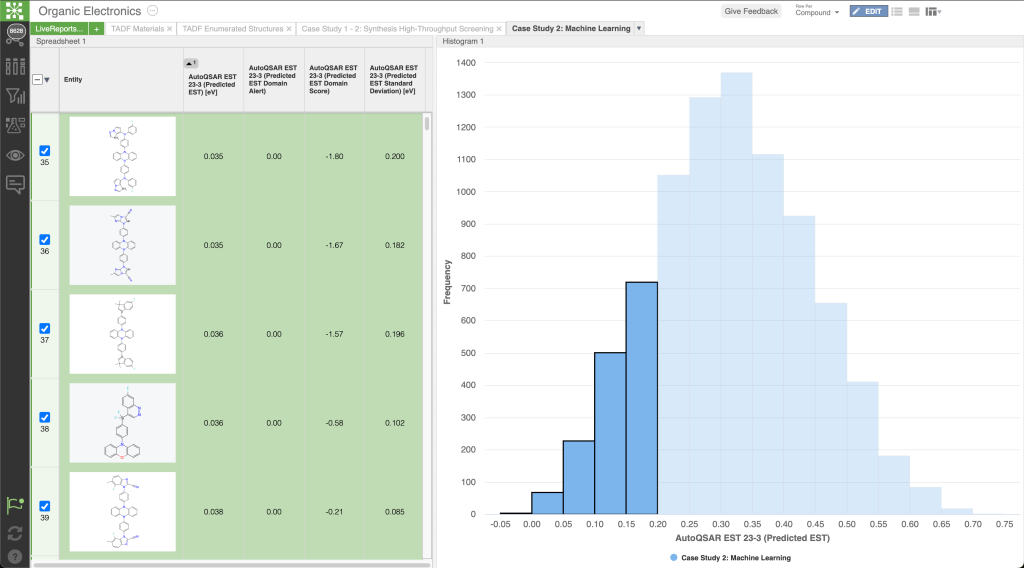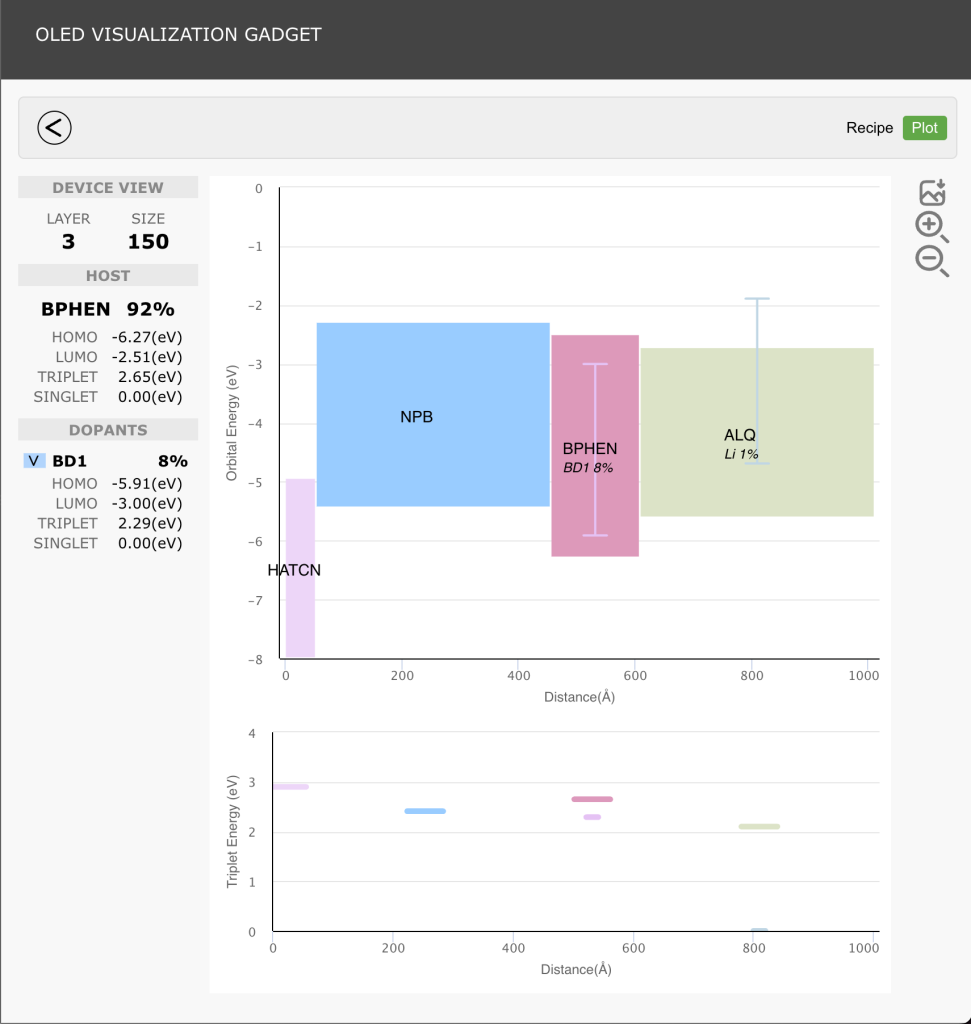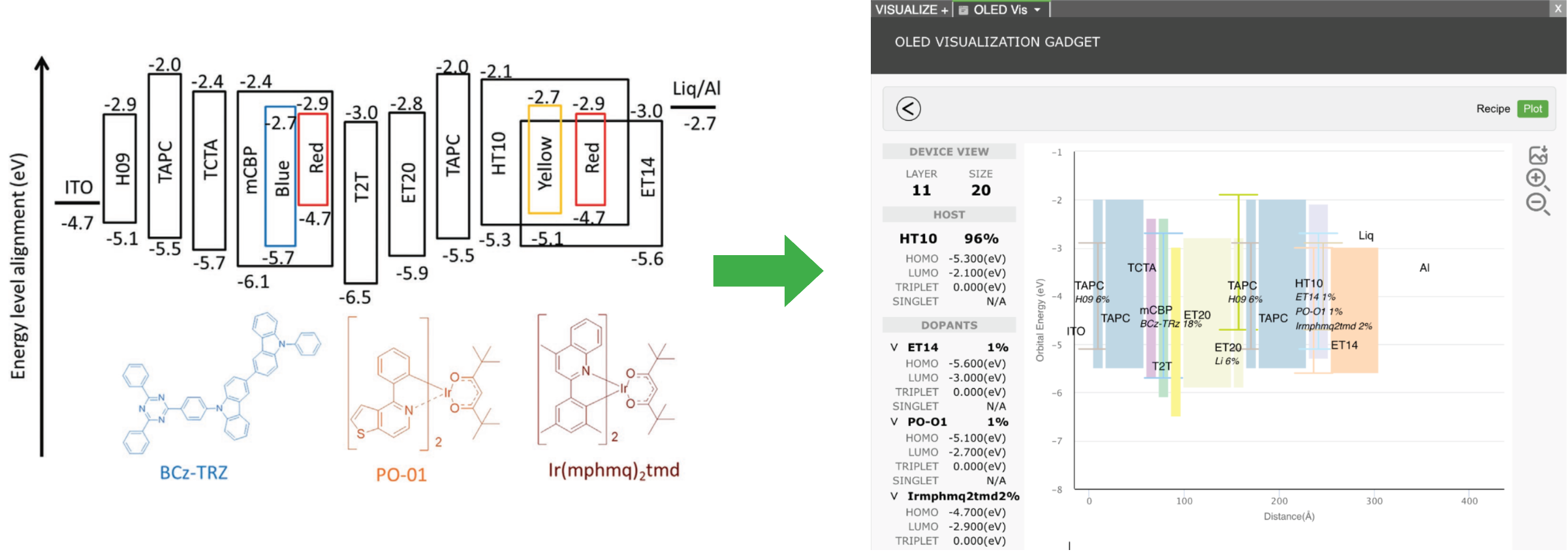LiveDesign for Organic Electronics
Combining Molecular Modeling, Machine Learning, and Enterprise Informatics to Accelerate R&D
Schrödinger’s LiveDesign is a flexible, cloud-native working environment to democratize digital design processes for new materials and improved formulations across R&D teams. From a single web-based platform, teams can access physics-based modeling, advanced cheminformatics, chemistry-informed machine learning, virtual design and analysis technologies, and project data. With features designed specifically for organic electronics, scientists can leverage the power of LiveDesign at every stage of the OLED materials R&D process: ideation, execution, data analysis and processing, data storage, and project management.
Overview
One-click access to powerful molecular and thin film simulations and machine learning workflows
- Accurately predict optoelectronic properties of materials with just one click using automated workflows
- Explore vast chemical space with large-scale screening of properties using integrated machine learning technologies
Plug-and-play with 3rd party data and scripts for efficient data management and processing
- Automatically import experimental data from ELN/database
- Complement any 3rd party/in-house programs/ scripts e.g. python, bash, perl, etc.
- Enable flexible visualization of complex datasets through forms view
Real-time collaborative management of materials chemistry and device data
- Securely and instantly share large-scale chemistry data across teams and partners to foster collaboration, empower innovation, and facilitate improved decision-making
Intuitive visualization of materials chemistry and device performance
- Visualize device configuration using experimental or computer-simulated data
- Gain insights into device architecture and performance to speed up decision-making processes and accelerate R&D timelines
CASE STUDY: LEVERAGING LIVEDESIGN TO DESIGN BETTER ORGANIC ELECTRONICS, FASTER
High-throughput screening of hole transport materials for QLEDs with easy-to-use, automated workflows
Solution-processed colloidal quantum dot light-emitting diodes (QLEDs) have garnered significant attention for optoelectronic applications. Nevertheless, the widespread adoption of QLED devices faces significant hurdles. The energy level mismatch between commonly used quantum dots (QDs) and traditional hole transport materials (HTMs) leads to an imbalance in charge carriers within the lightemitting layer (EML) and thus lower efficiency of OLED devices. In this study, we utilize high-throughput density functional theory (DFT) calculations on an extensive materials library comprising approximately 9,000 candidates to identify potential materials characterized by deep HOMO levels.
Schrödinger’s LiveDesign enables high-throughput quantum mechanical calculations for materials libraries of any size to predict their optoelectronic properties. One-click simulation execution allows an automated physics-based estimation of key electronic properties such as orbital energies and reorganization energies. The HOMO energies from DFT predictions as compared to experimental measurements for a set of known molecular compounds aligned well (R2=0.93), validating the DFT method, ensuring robust and accurate predictions of the orbital energies.
For high-throughput screening of the 9,000 compound library, we employed an automated workflow available in LiveDesign. First, we selected the compounds with hole reorganization energies less than 0.2 eV, see upper-right plot in Figure 1. Next, LiveDesign enables narrowing down our materials search further to those with a deep HOMO level (< -6.4 eV), and high LUMO level (> -3.0 eV), see lower-right plot in Figure 1. We search for materials with LUMO levels higher than -3.0 eV to ensure a significant energy mismatch with the conduction band of QDs (−4.0 eV), blocking electron injection from the light-emitting layer to the HTM. The chemical structures and properties of the top candidates are shown in the left panel in Figure 1.
Flexible visualization of complex datasets enables fast processing of big data, accelerating characterization and selection of promising candidates for post-processing investigation and further experimentation. LiveDesign empowers you with multi-parameter analysis, swiftly sorting through top candidates to discover those with precisely tailored properties.

CASE STUDY: LEVERAGING LIVEDESIGN TO DESIGN BETTER ORGANIC ELECTRONICS, FASTER
Machine learning for fast screening of thermally activated delayed fluorescence (TADF) emitters
TADF emitters are a promising class of molecules for achieving high quantum efficiencies in OLEDs. In such emitters, the energetic separation between the S1 and T1 excited states (ΔEST) needs to be small (< 0.2 eV), which allows reverse intersystem crossing to up-convert the T1 state to the emissive S1 state. Tuning ΔEST allows for higher efficiency light emission in the form of delayed fluorescence.
We imported experimental data of a set of TADF molecules to LiveDesign and employed integrated machine learning workflows to develop quantitative structure-property relationships (QSPR) models. The machine learning models were then used to predict ΔEST for the library of 9,000 molecules used in the above case study.
After plotting the distribution of predicted ΔEST for the compounds (Figure 2, right plot), we selected the ones with ΔEST < 0.2. The corresponding material structures and properties are shown on the left side.
While this case study provides a focused exploration of leveraging ML models for the swift estimation of ΔEST, it serves as just one illustrative example. The platform stands ready to be seamlessly tailored for diverse material classes and a spectrum of applications, showcasing its adaptability and versatility in addressing a multitude of scientific and industrial challenges.

CASE STUDY: LEVERAGING LIVEDESIGN TO DESIGN BETTER ORGANIC ELECTRONICS, FASTER
Visualization of OLED device structure for ideation
Efficiency and overall performance of electronic devices are influenced by various factors, including carrier injection, charge mobility, and device architecture. Specifically, for high-efficiency OLEDs, a multilayer device structure is employed, comprising a hole-injection/transport layer (HIL/ HTL), an emissive layer (EML), and an electron-injection/ transport layer (EIL/ETL). Such multilayer devices pose a serious challenge, requiring the use of materials with appropriate molecular orbital energy levels and excited states energies, with a key criterion being the minimization of carrier-injection barriers across the layers.
Schrödinger’s LiveDesign enables employing state-of-theart simulation methods to investigate the configuration of potential devices by considering layer thickness, orbital levels, dopant concentration, and excited state energies. As shown in Figure 3, we used data from different OLED materials (experimental or simulated properties) to visualize possible OLED device structures for quick screening of interlayer energy mismatch. The energy level mismatch is a key in OLED devices, impacting charge recombination in emissive layers along with excited state energies of components to determine device color and possibility of intermolecular energy transfer. This approach in LiveDesign allows scientists to quickly share and discuss efficiently towards the next step of designing next-generation OLEDs with higher performance.

Summary
Schrödinger’s LiveDesign offers a complete solution for the design of organic electronics across R&D teams. Integrated with physics-based simulations and machine learning, LiveDesign serves as an easy-to-use portal for efficient simulations for property prediction and largescale screening of organic electronic materials.
Meanwhile, LiveDesign is an efficient tool for teams to share, manage and process data, speeding up collaboration and innovation timelines. Moreover, with modules designed for organic electronics, scientists are able to visualize organic electronic devices, gaining insights on device performance.
Software and services to meet your organizational needs
Software Platform
Deploy digital materials discovery workflows with a comprehensive and user-friendly platform grounded in physics-based molecular modeling, machine learning, and team collaboration.
Research Services
Leverage Schrödinger’s expert computational scientists to assist at key stages in your materials discovery and development process.
Support & Training
Access expert support, educational materials, and training resources designed for both novice and experienced users.
